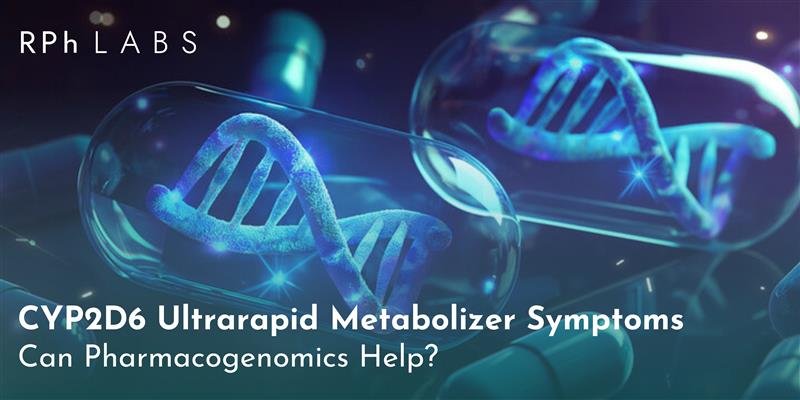
CYP2D6 Ultrarapid Metabolizer Symptoms: Can Pharmacogenomics Help?
Cytochrome P450 2D6, commonly referred to as CYP2D6 is one of the key enzymes in the liver responsible for metabolizing approximately 25% of clinically used medications. Ultrarapid metabolizers have an increased rate of converting prodrugs, such as codeine and tramadol, into their active forms (morphine and O-desmethyltramadol, respectively). This rapid conversion can lead to a sudden and excessive accumulation of the active drug in the bloodstream. CYP2D6 ultrarapid metabolizer symptoms include (not limited to) opioid toxicity (when opioids requiring activation by cyp2d6 are consumed), which may include severe sedation and respiratory depression. On the other hand, with drugs that are directly active and don’t require metabolic activation, ultrarapid metabolizers may clear the medication too quickly, leading to reduced therapeutic effects and potentially requiring higher doses.
This enzyme plays a pivotal role in breaking down various drug classes, including antidepressants, opioids, beta-blockers, and antipsychotics. CYP2D6 is highly polymorphic, meaning that its activity varies significantly among individuals due to genetic differences. People have different versions of the CYP2D6 gene, resulting in varying enzyme activity levels. Based on their genetic makeup, individuals can be categorized as poor, intermediate, extensive (normal), or ultrarapid metabolizers. Some medications might not be suitable for you while you may be a poor or rapid metabolizer of others, thus, a PGx test giving genome insights can save you from trial and error.
What Does CYP2D6 Ultrarapid Metabolizer Mean?
A CYP2D6 ultrarapid metabolizer (UM) is someone whose body processes drugs metabolized by CYP2D6 at an accelerated rate. This happens due to multiple active copies of the CYP2D6 gene, leading to higher-than-normal enzyme activity.
While being an ultrarapid metabolizer might sound advantageous, it can actually create problems with certain medications. Drugs that require activation by CYP2D6 may become overly potent, leading to an increased risk of side effects. On the other hand, medicines that need to stay in the bloodstream longer to be effective may be eliminated too quickly, resulting in reduced therapeutic benefit.
CYP2D6 Ultrarapid Metabolizer Symptoms Explained
Ultrarapid metabolizers may experience different symptoms depending on the type of medication they are taking. Here’s a breakdown of how it affects various drug categories:
1. Opioids (e.g., Codeine, Tramadol)
Codeine and tramadol require activation by CYP2D6 to convert into their active forms (morphine and O-desmethyl tramadol, respectively). In ultrarapid metabolizers, this conversion happens too quickly, potentially leading to dangerously high levels of the active drug in the bloodstream. This can result in:
- Excessive sedation
- Respiratory depression (in severe cases)
- Increased risk of opioid toxicity, even at standard doses
2. Antidepressants (e.g., Fluoxetine, Paroxetine)
CYP2D6 processes many antidepressants. In UMs, these drugs may be cleared from the body too rapidly, resulting in subtherapeutic levels and inadequate symptom relief. Symptoms include:
- Persistent depressive symptoms
- Poor response to antidepressant therapy
- Need for higher or alternative doses to achieve the desired effect
3. Beta-Blockers (e.g., Metoprolol)
Beta-blockers are commonly used to manage hypertension and heart conditions. UMs may metabolize these drugs too quickly, leading to insufficient blood pressure control or ineffective treatment of heart rate irregularities.
4. Antipsychotics (e.g., Risperidone, Haloperidol)
For drugs like risperidone, which are metabolized by CYP2D6, ultrarapid metabolism can reduce therapeutic efficacy. This can result in:
- Persistent psychotic symptoms
- Poor treatment outcomes
Can Pharmacogenomics Help CYP2D6 Ultrarapid Metabolizers?
Pharmacogenomics (PGx) testing can be highly beneficial for CYP2D6 ultrarapid metabolizers. PGx testing analyzes your genetic profile to identify how your body processes medications, helping healthcare providers tailor treatment plans that are both safe and effective.
Benefits of PGx Testing for CYP2D6 UMs:
1. Personalized Medication Selection:
Based on PGx test results, physicians can choose alternative medications not primarily metabolized by CYP2D6, reducing the risk of side effects or therapeutic failure.
2. Optimized Dosing:
For drugs that are essential and metabolized by CYP2D6, the PGx test can help determine the right dose to maintain effective blood concentration levels without causing toxicity.
3. Avoiding Trial and Error:
Traditionally, prescribing the right medication involves a trial-and-error approach, which can be time-consuming and frustrating for patients and providers. PGx testing eliminates much of this guesswork, improving treatment outcomes more quickly.
4. Preventing Adverse Drug Reactions (ADRs):
Since ultrarapid metabolizers are at increased risk of ADRs, especially with opioids, having prior knowledge through PGx testing can prevent serious complications.
Conclusion
CYP2D6 ultrarapid metabolizer symptoms may differ upon consuming different medications. PGx testing helps doctors select the right drug and correct doses based on your unique genome by providing insight into how your body processes different drugs. If you suspect you may be a CYP2D6 ultrarapid metabolizer or have experienced unusual responses to medications, consulting with a healthcare professional about PGx testing could be vital for your treatment plan.
References:
https://pmc.ncbi.nlm.nih.gov/articles/PMC5533497/
https://www.medsafe.govt.nz/profs/PUArticles/Mar2013Codeine.htm
https://www.frontiersin.org/journals/pharmacology/articles/10.3389/fphar.2021.624104/full
https://www.sciencedirect.com/topics/nursing-and-health-professions/cyp2d6



Leave a Reply